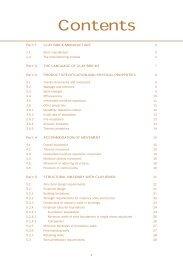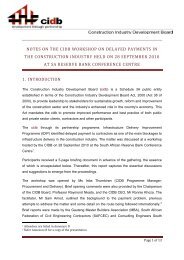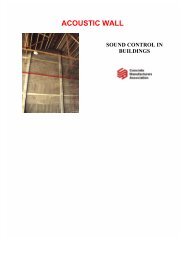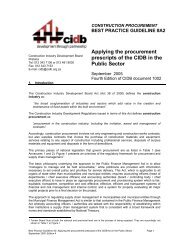MANUAL 4 - Construction Industry Development Board
MANUAL 4 - Construction Industry Development Board
MANUAL 4 - Construction Industry Development Board
You also want an ePaper? Increase the reach of your titles
YUMPU automatically turns print PDFs into web optimized ePapers that Google loves.
MODULE<br />
1<br />
2<br />
3<br />
4<br />
5<br />
6<br />
7<br />
Typical spreading team<br />
The spreading team comprises:<br />
• Two operators on the screed.<br />
• Two operators using the squeegees.<br />
• One operator cleaning any untoward spillage of<br />
slurry behind the screed, and use of the water<br />
hose.<br />
• Two operators laying the rails.<br />
<strong>MANUAL</strong> 4 – BITUMINOUS PAVEMENT SEALS<br />
• The barrow operators are responsible for site hygiene at the<br />
mixing site and road works site. Any spillage of slurry, emulsion<br />
or mud must be cleared, either by picking up the material and<br />
burying it or covering it up with gravel.<br />
• At the end of the shift, the barrow operators must clean their<br />
equipment and help clean the mixer, as well as park the mixer<br />
in a safe place.<br />
Spreading team duties:<br />
• Apart from their responsibilities associated with the placing of<br />
the slurry, the spreading team must check and rectify the<br />
levels of the base before any slurry is placed.<br />
4.2.2 Batching and mixing of slurry in concrete mixers<br />
• The area on which the concrete mixer and the emulsion drum stand is situated must<br />
be clean, well drained and have a sound surface to avoid dirt and mud being carried<br />
onto the base by the wheelbarrows. It must also be kept clean during operations to<br />
avoid bitumen being carried on to the new work by the wheelbarrows.<br />
• The aggregate to be used in the slurry must be dumped as close to the working site as<br />
possible, preferably at the mid point of the length of road that one load of aggregate<br />
will cover.<br />
• Using the measuring cans (Photo 4.18), add the correct amount of aggregate to the<br />
mixer drum while the drum is turning (Photo 4.19) in the proportions determined<br />
by the engineer. (For large mixers wheelbarrows may be used for batching the<br />
aggregate.)<br />
Photo 4.18<br />
IMPLEMENTING EMPLOYMENT INTENSIVE ROAD WORKS 42












